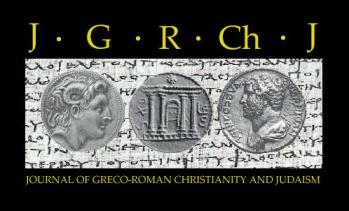4.1 | Flip-Flop? John Chrysostom's Polytropic Paul David Reis University of Oregon, Eugene, OR In antiquity, consistency in both word and deed was the hallmark of a virtuous
man. Alongside this discourse, however, a counter argument developed that praised
variability in speech or action, equating it with intellectual dexterity. For
ancient writers, Odysseus, the ‘man of many ways’, was the central character in this
debate; for many early Christians, the primary figure was Paul. This paper explores
polytropism through an analysis of Paul’s Corinthian correspondence and the writings
of John Chrysostom. Paul and Chrysostom both appropriate argumentation from the
Odyssean debate: the apostle finds it useful in defending his gospel, while the
bishop sees Paul’s versatility as not only an instrumental feature of his missionary
success, but a quality that his own Christian community should strive to
emulate. |
4.2 | Bakhtin and Lukan Politics: A Carnivalesque Reading of the Last Supper in the
Third Gospel Nathan Eubank Duke University, Durham, NC The third gospel does not proclaim a reversal of fortunes in which the lowly
are exalted over the powerful, as is commonly assumed. Rather, Luke destabilizes the
very definitions of lowliness and power in a manner that is best described by
Mikhail Bakhtin’s concept of the carnivalesque. To be more specific, the Lukan Last
Supper narrative rewrites the meaning of Jesus’ messianic status, poetically
juxtaposing death with political victory. This dialogical definition of Jesus’
identity is the proper framework through which to view Lukan politics as a
whole. |
4.3 | The Linguistic Situation in Jewish Palestine in Late Antiquity John C. Poirier Kingswell Theological Seminary, Cincinnati, OH The principal languages spoken in late antique Jewish Palestine, in descending
order of frequency, were Aramaic, Greek, and Hebrew. This article seeks to
establish, in the face of recent challenges, that Aramaic was indeed much more
commonly spoken than Hebrew. While the argument for a vernacular Hebrew is found
wanting, recent attempts to show the vernacular status of Greek in this same period
are judged correct in most respects. This article engages the texts and the
epigraphic evidence for this understanding of the linguistic situation, and briefly
visits how this relates to the perennial question of Jesus’ language of
instruction. |
4.4 | ‘What Now Lies Before Their Eyes’: The Foundations of Early Pilgrim Visuality in
the Holy Land Julie Ann Smith University of Sydney, Australia Pilgrims to the Holy Land in the late fourth and early fifth centuries
practiced culturally specific visualities that allowed them to perceive the holy
places as evidences that strengthened faith. This paper explores the writings of
Eusebius of Caesarea, Cyril of Jerusalem, Gregory of Nyssa, Athanasius of
Alexandria, Jerome, and Augustine about this kind of practice, and analyzes the
recorded experiences of three pilgrims: the Bordeaux Pilgrim, Egeria and
Paula. |
4.5 | The Contribution of Codex Bezae Cantabrigiensis to an Understanding of Women in
the Book of Acts David E. Malick Southeastern Bible College, Birmingham, AL Codex Bezae, also known as Codex D, a primary representative of the ‘Western’
text, has some significant differences in the Greek text of the book of Acts from
Codex B and the readings normally followed in the NA27 and UBSGNT fourth edition
texts. This article investigates those that appear to be intentional variants that
reflect theological ideas about women in the early Church, in Acts 1:14; 16:14, 15,
40; 17:4, 12, 34; 18:2-3, 7, 26, and concludes that Codex B pictures women as
co-participants and co-workers with men in ministry to a greater degree than Codex
D. |
4.6 | Genre, Sub-Genre and Questions of Audience: A Proposed Typology for Greco-Roman
Biography Justin M. Smith St. Mary’s College, University of St. Andrews, Scotland The communicative and relational matrix of author-subject-audience serves as
an important and valuable lens through which to understand and evaluate texts. This
is especially true of the genre of Greco-Roman biography, which was written by
individuals (author), about individuals (subject) and for readers/listeners
(audience). A number of typologies have been offered as a means of sub-dividing
Greco-Roman biography, yet none has taken into account the aforementioned
communicative matrix. This article offers a new typology for Greco-Roman biography
that takes into account the relationships among the authors, the subjects and the
audiences of ancient biographies. |

